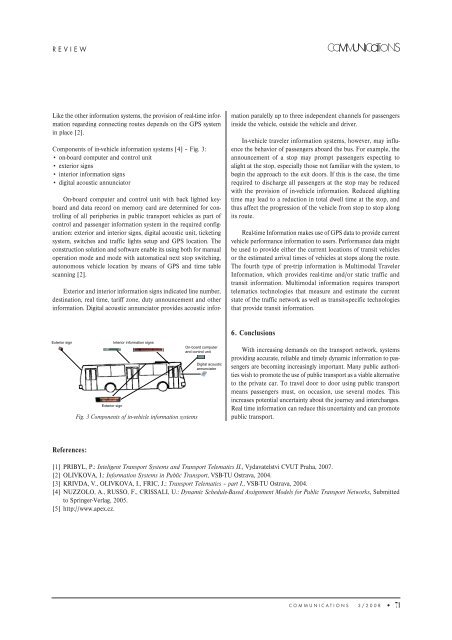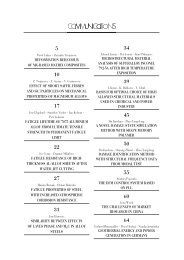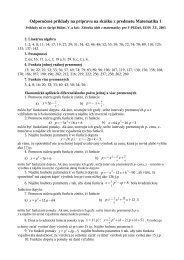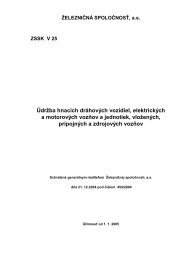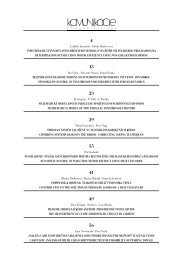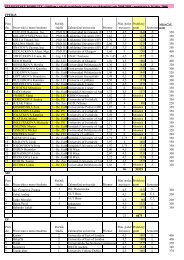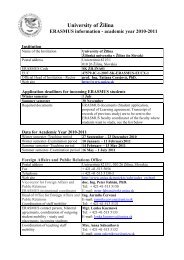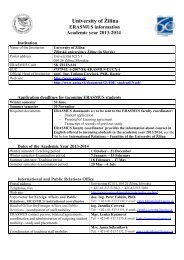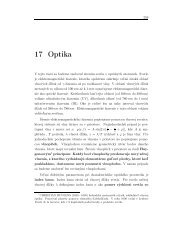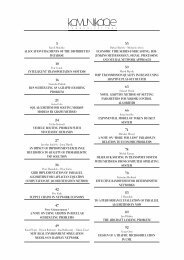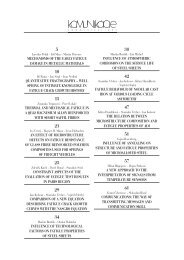REVIEW<strong>of</strong> transfers. With <strong>the</strong>se criteria in mind, <strong>the</strong> passenger may choosefrom <strong>the</strong> altern<strong>at</strong>ive trip plans th<strong>at</strong> connect <strong>the</strong>ir origin to <strong>the</strong>irdestin<strong>at</strong>ion.Passenger response to pre-trip inform<strong>at</strong>ion has been hypo<strong>the</strong>sizedand modeled in <strong>the</strong> liter<strong>at</strong>ure. It is important to distinguishbetween low frequency, regular services (e.g. suburban and <strong>of</strong>f-peakurban routes) and high frequency, irregular services (e.g. urbanroutes) when considering transit passenger route choice. It is generallyassumed th<strong>at</strong>, for low frequency services, passengers chooseboth <strong>the</strong> stop and <strong>the</strong> trip (i.e. scheduled departure time) before<strong>the</strong> trip begins. With high frequency services, passengers areassumed to choose only <strong>the</strong> stop prior to starting <strong>the</strong> trip.The choice <strong>of</strong> various stops on routes th<strong>at</strong> serve <strong>the</strong> passenger’sdestin<strong>at</strong>ion can be modeled according to random utility <strong>the</strong>ory,where each candid<strong>at</strong>e stop in <strong>the</strong> choice <strong>set</strong> has some utility valueth<strong>at</strong> is a function <strong>of</strong> <strong>the</strong> stop’s <strong>at</strong>tributes. Therefore, various types<strong>of</strong> pre-trip inform<strong>at</strong>ion (e.g. schedules, estim<strong>at</strong>ed arrival times)might contribute to <strong>the</strong> perceived utility <strong>of</strong> a stop and have a significantimpact on passenger pre-trip stop choice. For high frequencyservices, it is assumed th<strong>at</strong> passengers develop, prior todeparture, a choice <strong>set</strong> <strong>of</strong> candid<strong>at</strong>e routes th<strong>at</strong> serve <strong>the</strong> originstop. Choice <strong>of</strong> <strong>the</strong> actual trip from <strong>the</strong> <strong>set</strong> <strong>of</strong> altern<strong>at</strong>ive routes isassumed to take place en-route. However, pre-trip st<strong>at</strong>ic and/orreal-time inform<strong>at</strong>ion can play an important role in <strong>the</strong> passenger’sconsider<strong>at</strong>ion <strong>of</strong> possible routes.4. In-Terminal Inform<strong>at</strong>ion SystemsPassenger inform<strong>at</strong>ion systems th<strong>at</strong> provide inform<strong>at</strong>ion topassengers while <strong>the</strong>y wait <strong>at</strong> stops are designed to provide waitingcustomers with current inform<strong>at</strong>ion regarding delays, estim<strong>at</strong>edarrival times and o<strong>the</strong>r real-time <strong>vehicle</strong> performance d<strong>at</strong>a.The dynamic stop inform<strong>at</strong>ion system (DIS) makes it possibleto inform visually and acoustically <strong>the</strong> passengers in <strong>the</strong> publictransport<strong>at</strong>ion about <strong>the</strong> actual situ<strong>at</strong>ion on <strong>the</strong> particular stop(Fig. 2). The system compares <strong>the</strong> time table with <strong>the</strong> actual trafficsitu<strong>at</strong>ion monitored by <strong>the</strong> following <strong>of</strong> <strong>the</strong> <strong>vehicle</strong>s position withFig. 2 The dynamic stop inform<strong>at</strong>ion system<strong>the</strong> help <strong>of</strong> <strong>the</strong> s<strong>at</strong>ellite navig<strong>at</strong>ion system GPS. The d<strong>at</strong>a about<strong>the</strong> bus loc<strong>at</strong>ion are transmitted from <strong>the</strong> <strong>vehicle</strong>s by means <strong>of</strong> <strong>the</strong>radio communic<strong>at</strong>ion adapter with <strong>the</strong> GSM /GPRS modulus into<strong>the</strong> central traffic inform<strong>at</strong>ion centre (CETIS). In <strong>the</strong> CETIS <strong>the</strong>d<strong>at</strong>a are processed and <strong>the</strong>y can be completed by <strong>the</strong> time table.The inform<strong>at</strong>ion about time devi<strong>at</strong>ions <strong>of</strong> <strong>the</strong> buses from <strong>the</strong> timetable is conveyed in <strong>the</strong> real-time with <strong>the</strong> help <strong>of</strong> <strong>the</strong> Internet(Intranet) to <strong>the</strong> applic<strong>at</strong>ion computer <strong>at</strong> <strong>the</strong> stop or <strong>at</strong> <strong>the</strong> st<strong>at</strong>ion.The passengers are in a position to w<strong>at</strong>ch <strong>the</strong> inform<strong>at</strong>ion about<strong>the</strong> actual traffic situ<strong>at</strong>ion on <strong>the</strong> large area colour display panel.The visually impaired and handicapped persons outfitted by <strong>the</strong>command transmitter can solicit <strong>the</strong> inform<strong>at</strong>ion in <strong>the</strong> acousticform [4].The inform<strong>at</strong>ion provided <strong>at</strong> transit stops may or may not influencepassenger route choice. For low frequency, regular services,it is assumed th<strong>at</strong> passengers have already chosen a stop and a tripprior to departure. Therefore, in <strong>the</strong> case <strong>of</strong> low frequency services,in-terminal/wayside inform<strong>at</strong>ion may be used to ease customer frustr<strong>at</strong>ionand imp<strong>at</strong>ience during delays. However, in-terminal/waysideinform<strong>at</strong>ion can influence <strong>the</strong> passenger’s en-route decision-makingbehavior in <strong>the</strong> case <strong>of</strong> high frequency services. For example, ifmore than one route serves <strong>the</strong> origin stop, <strong>the</strong> passenger maychoose from among a <strong>set</strong> <strong>of</strong> approaching <strong>vehicle</strong>s th<strong>at</strong> serve <strong>the</strong>destin<strong>at</strong>ion.According to random utility <strong>the</strong>ory, each approaching candid<strong>at</strong>etrip has some utility associ<strong>at</strong>ed with it, which might be a function<strong>of</strong> passenger inform<strong>at</strong>ion [3]. The utility <strong>of</strong> an approachingtrip in <strong>the</strong> choice <strong>set</strong> as a function <strong>of</strong>:• Waiting time (<strong>the</strong> difference between <strong>the</strong> estim<strong>at</strong>ed arrival time<strong>of</strong> a trip and <strong>the</strong> estim<strong>at</strong>ed arrival time <strong>of</strong> <strong>the</strong> base trip), providedby <strong>the</strong> inform<strong>at</strong>ion system• In-<strong>vehicle</strong> travel time• Transfer time to <strong>the</strong> connecting trip• Number <strong>of</strong> passengers• On-board comfort (i.e. level <strong>of</strong> crowding on-board between <strong>the</strong>origin and destin<strong>at</strong>ion stops)• Time already spent <strong>at</strong> <strong>the</strong> stop5. In-Vehicle Inform<strong>at</strong>ion SystemsIn-<strong>vehicle</strong> inform<strong>at</strong>ion systems use public address systems,ei<strong>the</strong>r autom<strong>at</strong>ed or performed by <strong>the</strong> oper<strong>at</strong>or, variable messagesigns and o<strong>the</strong>r on-board systems to communic<strong>at</strong>e inform<strong>at</strong>ion to<strong>the</strong> passengers. In-<strong>vehicle</strong> inform<strong>at</strong>ion might include <strong>the</strong> name <strong>of</strong><strong>the</strong> next stop, transfer opportunities <strong>at</strong> <strong>the</strong> stop, points <strong>of</strong> interestnear <strong>the</strong> stop, and o<strong>the</strong>r inform<strong>at</strong>ion rel<strong>at</strong>ing to upcoming stops.There is less opportunity to influence a passenger’s route choicedecision-making on a transit <strong>vehicle</strong>, since <strong>the</strong> passenger has alreadychosen a stop <strong>at</strong> which to board, <strong>the</strong> <strong>vehicle</strong> (or trip) and, presumably,a destin<strong>at</strong>ion. However, some real-time inform<strong>at</strong>ion, suchas <strong>the</strong> whereabouts <strong>of</strong> connecting <strong>vehicle</strong>s <strong>at</strong> downstream stopsmight be conveyed using in-<strong>vehicle</strong> inform<strong>at</strong>ion systems. The user,<strong>the</strong>n, may upd<strong>at</strong>e <strong>the</strong> destin<strong>at</strong>ion stop choice or begin planning<strong>the</strong> next leg <strong>of</strong> <strong>the</strong> trip based on <strong>the</strong> prevailing connection prospects.70 ● COMMUNICATIONS 3/2008
REVIEWLike <strong>the</strong> o<strong>the</strong>r inform<strong>at</strong>ion systems, <strong>the</strong> provision <strong>of</strong> real-time inform<strong>at</strong>ionregarding connecting routes depends on <strong>the</strong> GPS systemin place [2].Components <strong>of</strong> in-<strong>vehicle</strong> inform<strong>at</strong>ion systems [4] – Fig. 3:• on-board computer and control unit• exterior signs• interior inform<strong>at</strong>ion signs• digital acoustic annunci<strong>at</strong>orOn-board computer and control unit with back lighted keyboardand d<strong>at</strong>a record on memory card are determined for controlling<strong>of</strong> all peripheries in public transport <strong>vehicle</strong>s as part <strong>of</strong>control and passenger inform<strong>at</strong>ion system in <strong>the</strong> required configur<strong>at</strong>ion:exterior and interior signs, digital acoustic unit, ticketingsystem, switches and traffic lights <strong>set</strong>up and GPS loc<strong>at</strong>ion. Theconstruction solution and s<strong>of</strong>tware enable its using both for manualoper<strong>at</strong>ion mode and mode with autom<strong>at</strong>ical next stop switching,autonomous <strong>vehicle</strong> loc<strong>at</strong>ion by means <strong>of</strong> GPS and time tablescanning [2].Exterior and interior inform<strong>at</strong>ion signs indic<strong>at</strong>ed line number,destin<strong>at</strong>ion, real time, tariff zone, duty announcement and o<strong>the</strong>rinform<strong>at</strong>ion. Digital acoustic annunci<strong>at</strong>or provides acoustic inform<strong>at</strong>ionparalelly up to three independent channels for passengersinside <strong>the</strong> <strong>vehicle</strong>, outside <strong>the</strong> <strong>vehicle</strong> and driver.In-<strong>vehicle</strong> traveler inform<strong>at</strong>ion systems, however, may influence<strong>the</strong> behavior <strong>of</strong> passengers aboard <strong>the</strong> bus. For example, <strong>the</strong>announcement <strong>of</strong> a stop may prompt passengers expecting toalight <strong>at</strong> <strong>the</strong> stop, especially those not familiar with <strong>the</strong> system, tobegin <strong>the</strong> approach to <strong>the</strong> exit doors. If this is <strong>the</strong> case, <strong>the</strong> timerequired to discharge all passengers <strong>at</strong> <strong>the</strong> stop may be reducedwith <strong>the</strong> provision <strong>of</strong> in-<strong>vehicle</strong> inform<strong>at</strong>ion. Reduced alightingtime may lead to a reduction in total dwell time <strong>at</strong> <strong>the</strong> stop, andthus affect <strong>the</strong> progression <strong>of</strong> <strong>the</strong> <strong>vehicle</strong> from stop to stop alongits route.Real-time Inform<strong>at</strong>ion makes use <strong>of</strong> GPS d<strong>at</strong>a to provide current<strong>vehicle</strong> performance inform<strong>at</strong>ion to users. Performance d<strong>at</strong>a mightbe used to provide ei<strong>the</strong>r <strong>the</strong> current loc<strong>at</strong>ions <strong>of</strong> transit <strong>vehicle</strong>sor <strong>the</strong> estim<strong>at</strong>ed arrival times <strong>of</strong> <strong>vehicle</strong>s <strong>at</strong> stops along <strong>the</strong> route.The fourth type <strong>of</strong> pre-trip inform<strong>at</strong>ion is Multimodal TravelerInform<strong>at</strong>ion, which provides real-time and/or st<strong>at</strong>ic traffic andtransit inform<strong>at</strong>ion. Multimodal inform<strong>at</strong>ion requires transporttelem<strong>at</strong>ics technologies th<strong>at</strong> measure and estim<strong>at</strong>e <strong>the</strong> currentst<strong>at</strong>e <strong>of</strong> <strong>the</strong> traffic network as well as transit-specific technologiesth<strong>at</strong> provide transit inform<strong>at</strong>ion.Exterior signExterior signInterior inform<strong>at</strong>ion signsFig. 3 Components <strong>of</strong> in-<strong>vehicle</strong> inform<strong>at</strong>ion systemsOn-board computerand control unitDigital acousticannunci<strong>at</strong>or6. ConclusionsWith increasing demands on <strong>the</strong> transport network, systemsproviding accur<strong>at</strong>e, reliable and timely dynamic inform<strong>at</strong>ion to passengersare becoming increasingly important. Many public authoritieswish to promote <strong>the</strong> use <strong>of</strong> public transport as a viable altern<strong>at</strong>iveto <strong>the</strong> priv<strong>at</strong>e car. To travel door to door using public transportmeans passengers must, on occasion, use several modes. Thisincreases potential uncertainty about <strong>the</strong> journey and interchanges.Real time inform<strong>at</strong>ion can reduce this uncertainty and can promotepublic transport.References:[1] PRIBYL, P.: Inteligent Transport Systems and Transport Telem<strong>at</strong>ics II., Vydav<strong>at</strong>elstvi CVUT Praha, 2007.[2] OLIVKOVA, I.: Inform<strong>at</strong>ion Systems in Public Transport, VSB-TU Ostrava, 2004.[3] KRIVDA, V., OLIVKOVA, I., FRIC, J.: Transport Telem<strong>at</strong>ics – part I., VSB-TU Ostrava, 2004.[4] NUZZOLO, A., RUSSO, F., CRISSALI, U.: Dynamic Schedule-Based Assignment Models for Public Transport Networks, Submittedto Springer-Verlag, 2005.[5] http://www.apex.cz.COMMUNICATIONS 3/2008 ●71
- Page 5 and 6:
Mt = k$ Di(12) 4. Torsion moment at
- Page 7:
References[1] JOVANOVIC, R.: Tensio
- Page 10 and 11:
Fig. 3 Geometrical parameters of ch
- Page 12 and 13:
Fig. 13 10. eigenvector when the ei
- Page 14 and 15:
and D R _ y,wi=0 if y 0 (12) Dampe
- Page 16 and 17:
Fig. 22 Comfort for passengers for
- Page 18 and 19: 3. Intermodal trainsIntermodal trai
- Page 20 and 21: Fig. 2 Consignment reloading proces
- Page 22 and 23: attached to individual tracks shown
- Page 24 and 25: Juraj Gerlici - Tomas Lack *MODIFIE
- Page 26 and 27: After the insertion of the previous
- Page 28 and 29: where:k - is the basic spring stiff
- Page 30 and 31: [2] GERLICI, J., LACK, T.: Methods
- Page 32 and 33: Resulting from experience the degre
- Page 34 and 35: Upon this strengthening of pretensi
- Page 36 and 37: attained the 6th position of the be
- Page 38 and 39: Jozef Jandacka - Stefan Papucik - V
- Page 40 and 41: spacing of the fan from the measuri
- Page 42 and 43: 5. ConclusionFrom the results prese
- Page 44 and 45: REVIEWlines with numerous curves th
- Page 46 and 47: REVIEWmeters from the point of view
- Page 48 and 49: REVIEWBojan Cene - Aleksandar Rados
- Page 50: REVIEWthe year 2006 in Slovenia sta
- Page 53 and 54: REVIEWthat the GPS does not recogni
- Page 55 and 56: REVIEWRadomir Brkic - Zivoslav Adam
- Page 57 and 58: REVIEWfailures. For example, for an
- Page 59 and 60: REVIEWJan Krmela *COMPUTATIONAL MOD
- Page 61 and 62: REVIEWFor this reason tyres and whe
- Page 63 and 64: REVIEWFig. 6 Computational model
- Page 65 and 66: REVIEW- guarantee that the messages
- Page 67: REVIEWIvana Olivkova *PASSENGER INF
- Page 71 and 72: REVIEWFig. 1 Revolution of the poin
- Page 73 and 74: REVIEWFig. 4 Transformation of the
- Page 75 and 76: BOOK REVIEWKavicka, A., Klima, V.,


